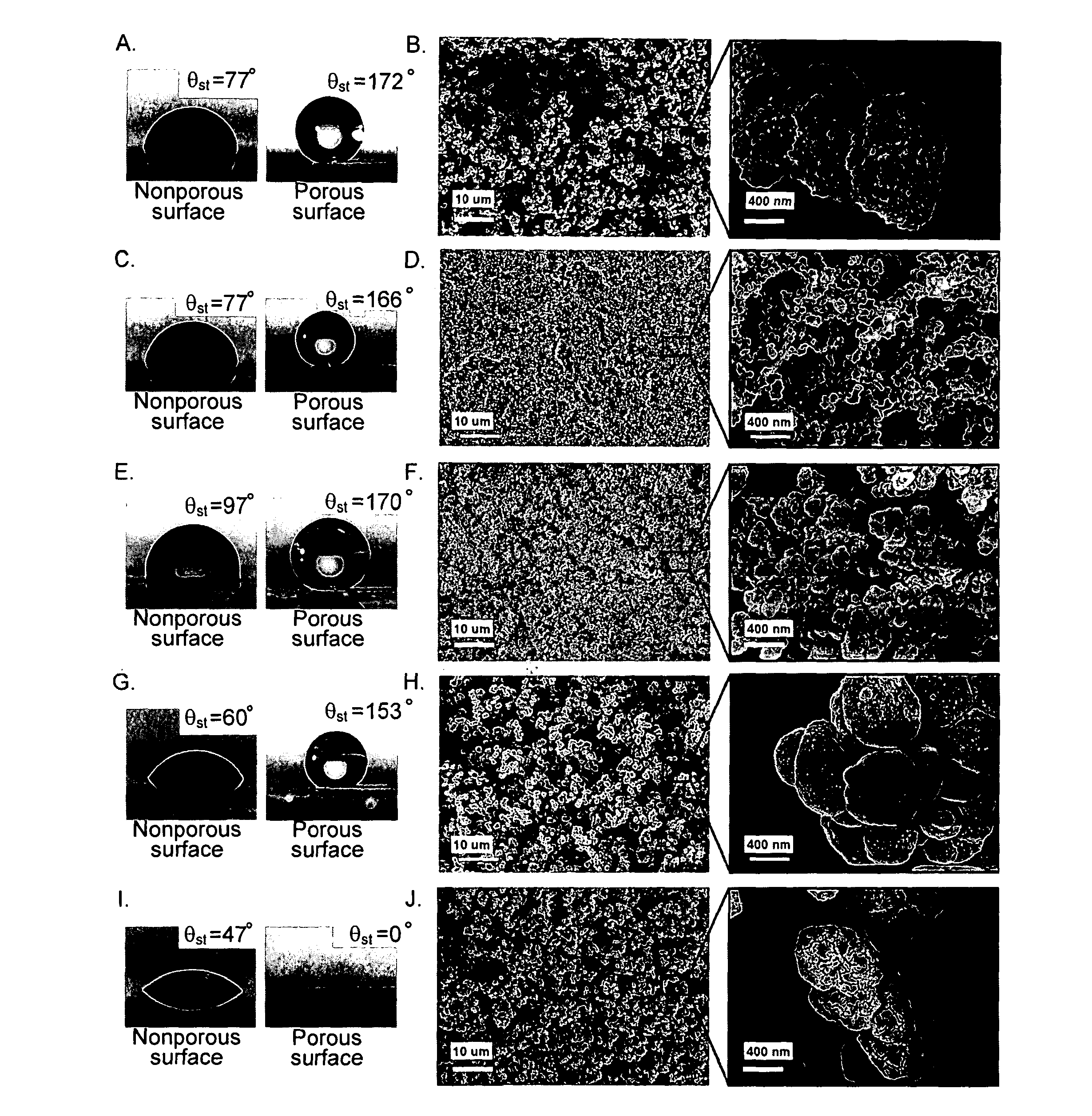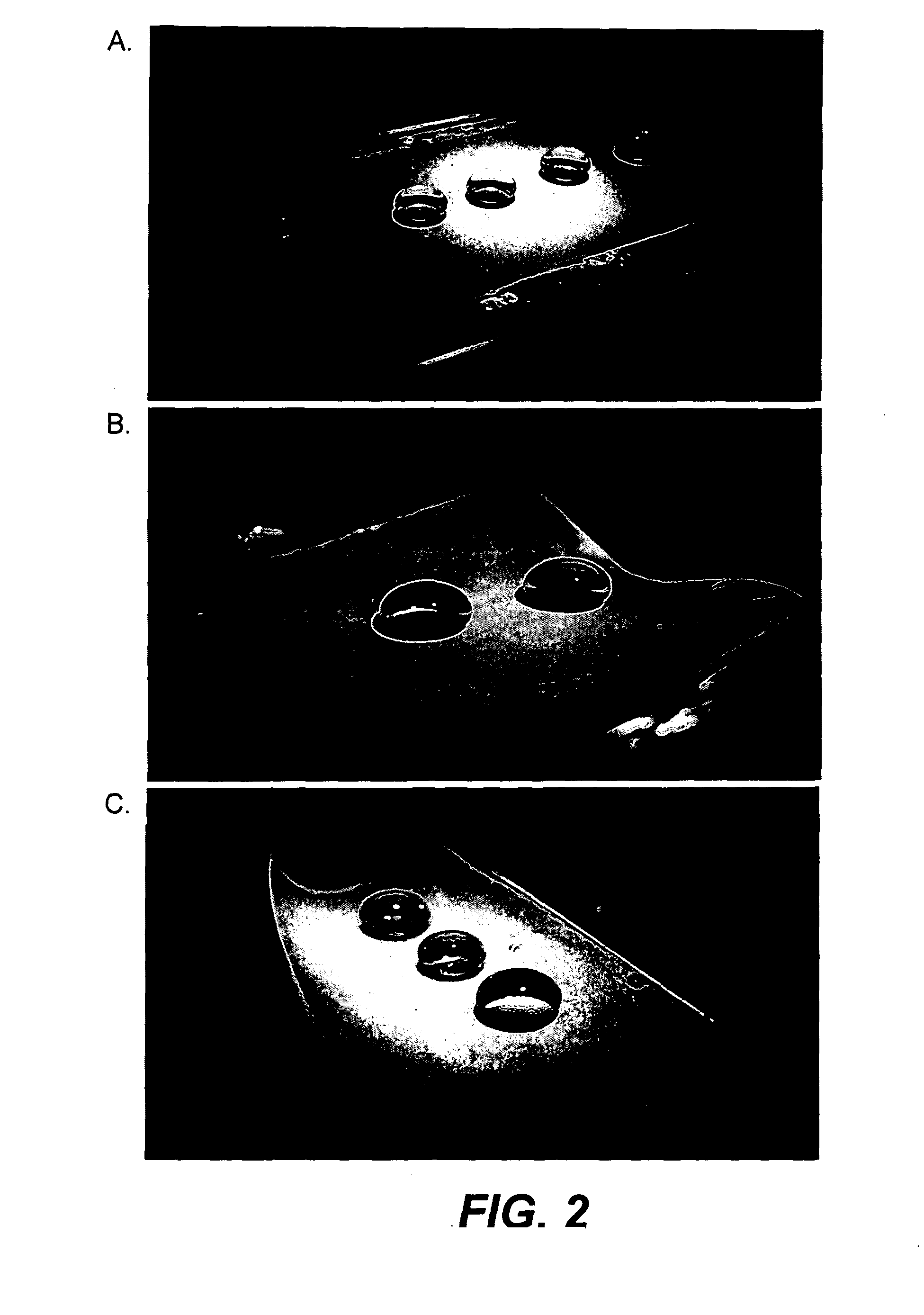Superhydrophobic and superhydrophilic materials, surfaces and methods
a superhydrophilic and material technology, applied in the field of superhydrophobic and superhydrophilic materials, surfaces and methods, can solve the problems of limited practical application of superhydrophobic surfaces, complex and costly reagents and equipment,
- Summary
- Abstract
- Description
- Claims
- Application Information
AI Technical Summary
Benefits of technology
Problems solved by technology
Method used
Image
Examples
example 1
Method of Making Superhydrophobic BuMA-EDMA Materials and Surfaces and their Properties
[0065]Photoinitiated polymerization of a mixture of butyl methacrylate (60% wt.) and ethylene dimethacrylate (40% wt.) in the presence of 2,2′-dimethoxy-2-phenylacetophenone as the UV initiator (1% wt.) between two glass plates leads to a transparent non-porous poly(butyl methacrylate-co-ethylene dimethacrylate) (BuMA-EDMA) layer with a smooth surface. The static water contact angle (θst) on this surface is 77° (FIG. 1a). However, when 20 parts of cyclohexanol and 40 parts of 1-decanol are added to 40 parts of the mixture of monomers and polymerized, the value of θst on the surface of the produced polymeric layer increases up to 172° (FIG. 1a). The advancing and receding water contact angles (θadv and θrec, respectively) increase from 89° and 66° to 174° and 171°, respectively. The polymer becomes superhydrophobic and water droplets bounce on its surface and easily roll off the surface even at a t...
example 2
Composition, Preparation and Properties of Other Superhydrophobic and Superhydrophilic Materials and Surfaces
[0075]To demonstrate the generality of the approach for the preparation of superhydrophobic materials, poly(styrene-co-divinylbenzene) as another common polymer with slightly more hydrophobic nature (intrinsic θst=97°) was studied. Because of the UV absorptive properties of the styrenic monomers, photopolymerization with 2,2′-dimethoxy-2-phenylacetophenone could not be used in this case. However, thermally initiated polymerization of a mixture of styrene (24% wt.), divinylbenzene (80% grade, 16% wt.), 1-decanol (50% wt.), tetrahydrofuran (10% wt.) and 2,2′-azobisisobutyronitrile (1% wt. with respect to monomers) afforded the porous poly(styrene-co-divinylbenzene) (ST-DVB). The θst on the produced porous polymer increased to 170° (FIG. 1e). The SEM micrographs revealed a network of interconnected microglobules with significantly smaller size in comparison to that of the BuMA-E...
example 3
Method of Making Superhydrophilic HEMA-EDMA and its Properties
[0079]Generating porosity on the surface of a significantly more hydrophilic poly(2-hydroxyethyl methacrylate-co-ethylene dimethacrylate) (HEMA-EDMA) polymer (intrinsic θst=47°) yielded a superhydrophilic material (both θst, θadv and θrec=0) (FIG. 1i,j). This is due to the fact that roughness increases both hydrophobicity and hydrophilicity of the material. Superhydrophilic materials have aroused great interest for potential practical applications such as self-cleaning windows and microfluidics. The porous HEMA-EDMA was prepared by free radical photopolymerization of a mixture of 2-hydroxyethyl methacrylate (24% wt.), ethylene dimethacrylate (16% wt.), 1-decanol (40% wt.), cyclohexanol (20% wt.) and 2,2-dimethoxy-2-phenylacetophenone (1% wt. with respect to monomers). The nonporous polymer used for measuring intrinsic water contact angles was obtained by polymerization of the same mixture of monomers 2-hydroxyethyl methac...
PUM
| Property | Measurement | Unit |
|---|---|---|
| Thickness | aaaaa | aaaaa |
| Surface properties | aaaaa | aaaaa |
| Adhesion strength | aaaaa | aaaaa |
Abstract
Description
Claims
Application Information
 Login to View More
Login to View More - R&D
- Intellectual Property
- Life Sciences
- Materials
- Tech Scout
- Unparalleled Data Quality
- Higher Quality Content
- 60% Fewer Hallucinations
Browse by: Latest US Patents, China's latest patents, Technical Efficacy Thesaurus, Application Domain, Technology Topic, Popular Technical Reports.
© 2025 PatSnap. All rights reserved.Legal|Privacy policy|Modern Slavery Act Transparency Statement|Sitemap|About US| Contact US: help@patsnap.com



